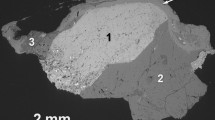Abstract
A new mineral vigrishinite, epistolite-group member and first layer titanosilicate with species-defining Zn, was found at Mt. Malyi Punkaruaiv, in the Lovozero alkaline complex, Kola Peninsula, Russia. It occurs in a hydrothermally altered peralkaline pegmatite and is associated with microcline, ussingite, aegirine, analcime, gmelinite-Na, and chabazite-Ca. Vigrishinite forms rectangular or irregularly shaped lamellae up to 0.05 × 2 × 3 cm flattened on [001]. They are typically slightly split and show blocky character. The mineral is translucent to transparent and pale pink, yellowish-pinkish or colorless. The luster is vitreous. The Mohs’ hardness is 2.5–3. Vigrishinite is brittle. Cleavage is {001} perfect. D meas = 3.03(2), D calc = 2.97 g/cm3. The mineral is optically biaxial (−), α = 1.755(5), β = 1.82(1), γ = 1.835(8), 2V meas = 45(10)°, 2V calc = 50°. IR spectrum is given. The chemical composition (wt %; average of 9 point analyses, H2O is determined by modified Penfield method) is as follows: 0.98 Na2O, 0.30 K2O, 0.56 CaO, 0.05 SrO, 0.44 BaO, 0.36 MgO, 2.09 MnO, 14.39 ZnO, 2.00 Fe2O3, 0.36 Al2O3, 32.29 SiO2, 29.14 TiO2, 2.08 ZrO2, 7.34 Nb2O5, 0.46 F, 9.1 H2O, −0.19 O=F2, total is 101.75. The empirical formula calculated on the basis of Si + Al = 4 is: H7.42(Zn1.30Na0.23Mn0.22Ca0.07Mg0.07K0.05Ba0.02)Σ1.96(Ti2.68Nb0.41Fe 3+0.18 Zr0.12)Σ3.39(Si3.95Al0.05)Σ4 20.31F0.18. The simplified formula is: Zn2Ti4−x Si4O14(OH,H2O,□)8 (x < 1). Vigrishinite is triclinic, space group P \(\bar 1\), a = 8.743(9), b = 8.698(9), c = 11.581(11)Å, α = 91.54(8)°, β = 98.29(8)°, γ = 105.65(8)°, V = 837.2(1.5) Å3, Z = 2. The strongest reflections in the X-ray powder pattern (d, Å, −I[hkl]) are: 11.7-67[001], 8.27-50[100], 6.94-43[0\(\bar 1\)1, \(\bar 1\)10], 5.73–54[1\(\bar 1\)1, 002], 4.17-65[020, \(\bar 1\) \(\bar 1\)2, 200], and 2.861-100[3\(\bar 1\)0, 2\(\bar 2\)2, 004, 1\(\bar 3\)1]. The crystal structure model was obtained on a single crystal, R = 0.171. Vigrishinite and murmanite are close in the structure of the TiSiO motif, but strongly differ from each other in part of large cations and H-bearing groups. Vigrishinite is named in honor of Viktor G. Grishin (b. 1953), a Russian amateur mineralogist and mineral collector, to pay tribute to his contribution to the mineralogy of the Lovozero Complex. The type specimen is deposited in the Fersman Mineralogical Museum of Russian Academy of Sciences, Moscow.
Similar content being viewed by others
References
Anthony, J.W., Bideaux, R.A., Bladh, K.W., and Nichols M.C. Handbook of mineralogy, vol. II. Silica, silicates, Tucson: Mineral Data Publishing, 1995.
Back, M.E. and Mandarino, J.A., Fleischer’s glossary of mineral species, 10th ed., The Mineralogical Record Inc., 2008.
Borneman-Starynkevich, I.D., On the chemical nature of murmanite, in Voprosy mineralogii, geokhimii i petrografii (Problems of mineralogy, geochemistry, and petrography), Moscow: AN SSSR, 1946, pp. 66–74.
Chukanov, N.V., Pekov, I. V., Zadov, A. E., et al., Mineraly gruppy labuntsovite (Mineral of the labuntsovite group), Moscow: Nauka, 2003.
Ferraris, G. and Gula, A., Polysomatic aspects of microporous minerals — heterophyllosilicates, polysepioles and rhodesite-related structures, Rev. Miner. Geochem, 2005, vol. 57, pp. 69–104.
Gerasimovsky, V.I., Mineralogy of the southeastern Luyavrurt, Tr. Lomonosov Inst. AN SSSR, Ser. Miner., 1936, no. 7, pp. 5–48.
Gerasimovsky, V.I., Ussingite from the Lovozero tundra, Tr. Lomonosov Inst. AN SSSR, Ser. Mineral., 1937, no. 10, pp. 5–28.
Karup-Möller, S., Murmanite from the Ilimaussaq alkaline complex, South Greenland, Neues Jahrb. Miner. Abh., 1986, vol. 155, pp. 67–88.
Khalilov, A.D., The refinement of the crystal structure of murmanite and new data on its crystal chemistry, Mineral. Zh., 1989, vol. 11, no. 5, pp. 19–27.
Khomyakov, A.P., Mineralogy of hyperagpaitic alkaline rocks, Oxford: Clarendon Press, 1995.
Lykova, I.S, Chukanov, N.V., Tarasov, V.P., et al., Ionexchange properties of murmanite Na2Ti2(Si2O7)O2 · 2H2O, Russ. J. Phys. Chem. B, 2013, vol. 32, no. 4 (in press).
Pekov, I.V., Lovozerskii massiv: istoriya issledovaniya, pegmatity, mineraly (The Lovozero pluton: research history, pegmatites, and minerals), Moscow: Zemlya, 2001.
Pekov, I.V., Grigorieva, A.A., Turchkova, A.G., and Lovskaya, E.V., Natural ion exchange in microporous minerals: different aspects and implications, in Minerals as advanced materials I, Berlin; Heidelberg: Springer, 2008, pp. 7–15.
Piilonen, P.C., Pekov, I.V., Back, M., et al., Crystal structure refinement of a Zn-rich kupletskite from Mont Saint-Hilaire, Quebec, with contributions to the geochemistry of zinc in peralkaline environments, Miner. Mag., 2006, vol. 70, pp. 565–578.
Rastsvetaeva, R.K. and Andrianov, V.I., New data on crystal structure of murmanite, Kristallografiya, 1986, vol. 31, no. 1, pp. 82–87.
Semenov, E.I., Mineralogiya Lovozerskogo shchelochnogo massiva (Mineralogy of Lovozero alkaline pluton), Moscow: Nauka, 1972.
Sheldrick, G.M., A short history of SHELX, Acta Cryst., 2008, vol. A64, pp. 112–122.
Vlasov, K.A., Kuz’menko, M.V., and Es’kova, E.M., Lovozerskii shchelochnoi massiv (Lovozero pluton), Moscow: AN SSSR, 1959.
Zabavnikova, N.I., Water treatment of the lomonosovite-group minerals, in Metody khimicheskogo analiza i khimicheskii sostav mineralov (Methods of chemical analysis and chemical composition of minerals), Moscow: Nauka, 1967, pp. 69–78.
Author information
Authors and Affiliations
Corresponding author
Additional information
Original Russian Text © I.V. Pekov, S.N. Britvin, N.V. Zubkova, N.V. Chukanov, I.A. Bryzgalov, I.S. Lykova, D.I. Belakovskiy, D.Yu. Pushcharovsky, 2012, published in Zapiski Rossiiskogo Mineralogicheskogo Obshchestva, 2012, No. 4, pp. 12–26.
A new mineral vigrishinite and its name were recommended by the Commission on New Minerals, Russian Mineralogical Society and approved by the Commission on New Minerals, Nomenclature, and Mineral Classification of the International Mineralogical Association on October 5, 2011 (IMA no. 2011-073)
Rights and permissions
About this article
Cite this article
Pekov, I.V., Britvin, S.N., Zubkova, N.V. et al. Vigrishinite, Zn2Ti4 − x Si4O14(OH,H2O,□)8, a new mineral from the Lovozero alkaline complex, Kola Peninsula, Russia. Geol. Ore Deposits 55, 575–586 (2013). https://doi.org/10.1134/S107570151307009X
Received:
Published:
Issue Date:
DOI: https://doi.org/10.1134/S107570151307009X



